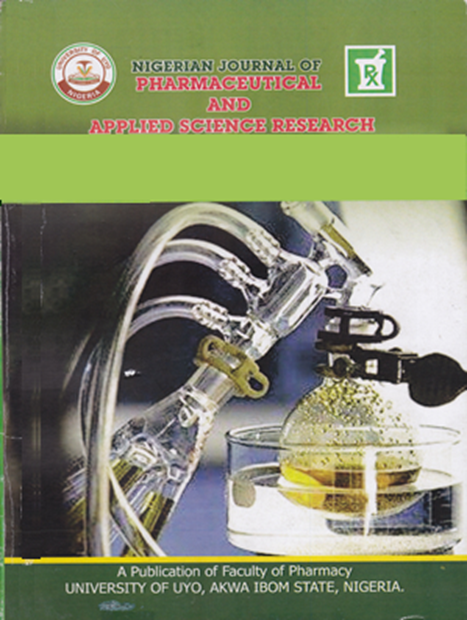Bioautography and GC-MS of the antidermatophytic components of the methanol leaf extract of Musa paradisiaca Linn
Main Article Content
Abstract
Background: The search for new agents from medicinal plants is on the increase because of the development of resistance to available drugs.
Methods: The methanol leaf extract of Musa paradisiaca Linn was investigated to isolate its antidermatophytic components. The extract was fractionated to pool the active compounds into the polar solvent. The functional groups present in the extract were detected by FTIR, while chemical components of the extract were separated by TLC methods before determining the activity of the separated components by bioautography. The components were isolated and tested for their individual activity against the test dermatophytes.
Results: Infrared spectra indicated the presence of organic compounds of the phenolic group. All the test organisms had varying degrees of susceptibility on the bioautoghrahy, with M. audouinii being more susceptible. GC-MS analysis of the components indicated the presence of oxirane tridecyl, 12-methyl-E, E-2, 13 octadecadien-1-ol, cis-7, cis-11-Hexadecadien-1-yl acetate, n-Hexadecanoic acid, cis-11-Hexadecenal, 2-Hexadecanol and butylated hydroxytoluene which are known to possess antifungal properties.
Conclusion: The leaf of M. paradisiaca is confirmed to possess antidermatophtytic potentials which can be exploited to produce leads for the development of novel antifungal agents.
Downloads
Article Details

This work is licensed under a Creative Commons Attribution-NonCommercial-NoDerivatives 4.0 International License.
References
Lewis, K. and Ausubel, F. M. Prospects for plant derived antibacterials. National Biotechnology 2006; 24(12): 1504-1507.
Dewanjee, S., Gangopadhyay, M., Bhattacharya, N., Khanra, R. and Dua, T. K. Bioautography and its scope in the field of natural product chemistry. Journal of Pharmaceutical Analysis 2015; 5(2): 75-84.
Ige, A. O., Mebude, O. O., Adeniyi, B. A. and Adewoye, E.O. Antidermatophytic activities of Musa sapientum methanol leaf extract in-vitro. British Microbiology Research Journal 2015; 10(1): 1-7.
Asuquo, E. G., Udobi, C. E and Eyibio O. O. In vitro Susceptibility Studies of the Extract, Fraction and Cream formulation of the leaf of Musa paradisiaca Linn against known Dermatophytes. Microbiology Research Journal International 2022; 32(8):21-29.
Udobi, C. E., Onaolapo, J. A. and Agunu, A. Antibacterial Activities and Bioactive components of Aqueous Fraction of the Stem Bark of Parkia biglobosa (Jacq) (Mimosacea). Nigerian Journal of Pharmaceutical Science 2008; 7:76-82.
Dissanayake, M. L., Ito, S. and Akakabe, Y. TLC bioautography guided detection and biological activity of antifungal compounds from medicinal plant Acorus calamus Linn. Asian Journal of Plant Pathology 2015; 9 (1):16-26.
Ausha, S., Praveen, C. H, Praveena, M., Jayanthi, M. and Sivakumar, V. Study of Antimicrobial Activity in Silver Nano Particles from Musa paradisiaca. Journal of Pharmacognosy and Phytochemistry 2021; 10(4): 94-102.
Ajijolakewu, K. A., Ayoola, A. S., Agbabiaka, T. O. Zakariyah, F. R., Ahmed, N. R., Oyedele, O. J and Sani, A. A Review of the Ethnomedicinal, Antimicrobial and Phytochemical Properties of Musa paradisiaca (plantain). Bulletin of the National Research Centre 2021; 45:86-88.
Udobi, C. E. and Onaolapo, J. A. (2012). Bioactive Compounds of the Stem Bark of Parkia Biglobosa. Journal of Applied Pharmaceutical Science 2012; 2(7): 133-137.
Singh, P., Mishra, S., Bhanushali, M., Karbhari, S. and Chundun, J. R. Bioanalytical, Antibacterial and Bioautographic assessment of spathe of Musa sp. International Journal of Life Sciences Research 2018; 6(2): 171-179.
Fahim, M., Ibrahim, M., Zahiruddin, S., Pareen, R., Khan, W. Ahmad, S., Shrivastava, B., Shrivastava, A. K. TLC-Bioautography identification and GC-MS analysis of antimicrobial and antioxidant active compounds in Musa paradisiaca L. fruit pulp essential oil. Phytochemical Analysis 2019; 30(3): 332-345.
Bhat, R., Kiran, K., Arun, A.B. and Karim, A. A. Determination of mineral composition and heavy metal content of some nutraceutically valued plant products. Food Analysis Methods 2010; 3:181-187.
Akpabio, U. D., Udiong, D. S and Akpakpan, A. E. The Physicochemical Characteristics of Plantain (Musa paradisiaca) and Banana (Musa sapientum) Pseudostem Wastes. Advances in Natural and Applied Sciences 2012; 6(2):167-172.
Rao, U.S. M., Mohd, K. S., Muhammad, A., Ahmad, B. A., Mohamad, M. and Ali, R. M. (2014). Taxonomical, Phytochemical and Pharmacological Reviews of Musa sapientum var paradisiaca. Research Journal of Pharmacy and Technology 2014; 7(11):1356-1361.
Boulogne, I., Petit, P., Desfontaines, L., Durambur, G., Deborde, C., Mirande-Ney, C., Anaudin, Q., Plasson, C., Grivotte, J., Chamot, C., Bernard, Sophie and Loranger-Merciris, G. Biological and Chemical Characterization of Musa paradisiaca Leachate. Biology. 2023; 12 (1326): 117.
Abdel Aziz, S. M., Ahmed, O. M., Abd EL-Twab, S. M., Al-Muzafar, H. M., Adel Amin, K. and AbdelGabbar, M. Antihypergycemic effects and mode of actions of Musa paradisiaca leaf and fruit peel hydroethanolic extracts in Nicotinamide/Streptozotocin-Induced Diabetic Rats. Evidence-Based Complementary and Alternative Medicine 2020; 2:1-15.
Deep, A., Upadhyay, O. N., Nandel, R., Kumar, S., Sharma, A. K. and Wadhwa, D. Anticancer potential of Musa paradisiaca as cervical carcinoma and malignant melanoma. Research Square 2021; 1: 1-16.
Chandran, M. Phytocompounds screening in the methanolic leaf extract of plant Senna italica by GCMS analysis. Journal of Emerging Technologies and Innovative Research 2015; 2(6):389-400.
Prasath, K. G., Alexpandi, R., Parasuraman, R., Pavithra, M., Ravi, A. V. and Pandian, S. K. Anti-inflammatory Potential of Myristic acid and Palmitic acid Synergism against Systemic Candidiasis in Danio rerio (Zebra fish). Biomedicine and Pharmacotherapy 2021; 133:1-7.
Francis, M., Chacha, M., Ndakidemi, P. A. and Mbega, E. R. Phytochemical Analysis and in vitro Antifungal Evaluation of Jathropha curcas against late Leaf spot Disease on Groundnut. Journal of Animal and Plant Sciences 2021; 47(1):8358-8371.
Bhattacharyya, A., Sinha, M., Singh, H., Patel, R. S., Ghosh, Sumana, Sardana, K., Ghosh, S. and Sengupta, S. Mechanistic insight into the antifungal effects of a fatty acid derivative against drug-resistant fungal infections. Frontiers in Microbiology 2020; 11:1-20.
Passone, M. A., Resnik, S. L. and Etcheverry, M. G. In vitro effect of phenolic antioxidants on germination, growth and aflatoxin B accumulation by peanut Aspergillus section Flavi. Journal of Applied Microbiology 2005; 99(3):682-691.


